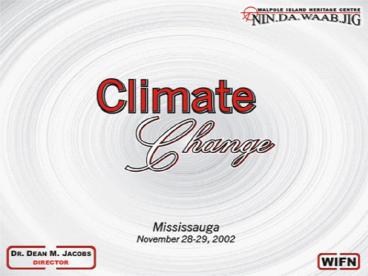Overview of Walpole Island First Nation - PowerPoint PPT Presentation
1 / 10
Title:
Overview of Walpole Island First Nation
Description:
Aboriginal groups, resource and environment issues ... Resource and Environment Issues by J. Fontaine, J. Gilbert, I. Jackson and D. Jacobs. ... – PowerPoint PPT presentation
Number of Views:28
Avg rating:3.0/5.0
Title: Overview of Walpole Island First Nation
1
2
TOPICS
- Overview of Walpole Island First Nation
- Issues of Concern facing WIFN and all First
Nation Communities - Methodology
- Concluding Remarks
3
WALPOLE ISLAND FIRST NATION
- 6 small Islands make up Walpole
Island First Nation - World Class Wetlands
- 350 square kilometers
4
WALPOLE ISLAND FIRST NATION
Walpole Island First Nation makes up only 0.002
of Canadas landmass, yet contains 12 of
Canadas wildlife species at risk (COSEWIC).
- Mammals (1)
- Fish (6)
- Birds (11)
- Reptiles (6)
- Plants (16)
- Butterflies (1)
- Historical Species (2)
COSEWIC Committee on the Status of Endangered
Wildlife in Canada
5
ISSUES OF CONCERN
6
METHODOLOGY
The specific approach that will be taken is based
on approaches that Walpole Island First Nation
already uses and a modified environmental risk
assessment and management approach framework that
necessarily involves the community to ensure the
effective identification, assessment and
implementation of adaptation measures.
Jones, R.N. 2001, An Environmental Risk
Assessment/Management Framework for Climate
Change Impact Assessments in Natural Hazards 23
197-230
7
CONSENSUS
- Whatever their system of government, many
Aboriginal people have spoken of the principle of
consensus as a fundamental part of their
traditions. Under this principle, all community
members should be involved in the process of
reaching agreement on matters of common interest
. . . - Through a prolonged process of formulation and
reformulation, consensus gradually emerges,
representing a blend of individual perspectives. - Canada, Royal Commission on Aboriginal Peoples,
Report
8
APPROACHES
- Time Span Anticipate potential effects at
least seven generations into the future - WIFN traditional knowledge and values
- Cumulative environmental effects
- Effective monitoring
- Effects on employment and revenue generation for
WIFN - Community feedback/consultation
9
MANAGEMENT
WIFN manages its environment by combining
traditional knowledge and values with modern
technology and science. WIFN carries into its
many outreach activities an insistence that human
needs are not primary, but rather that humans are
only part of an interconnected natural world.
10
CONCLUDING REMARKS
- Remember that environmental resources are
not just sets of issues for First Nations
in the way they tend to be considered by
non-Aboriginal society - From the standpoint of First Nations and
other Aboriginal groups, resource and
environment issues are often inseparably
linked to unresolved problems of
sovereignty and self-government - Recognize that the consensus principle may
require a very different approach to
negotiation and agreement than is typical
in the non-Aboriginal world
Ref. Resource and Environment Issues by J.
Fontaine, J. Gilbert, I. Jackson and D. Jacobs.
In Aboriginal Issues Today, 1997. International
Self-Counsel Press Ltd. Vancouver, B.C.































